Uffizi Gallery Guided Tour
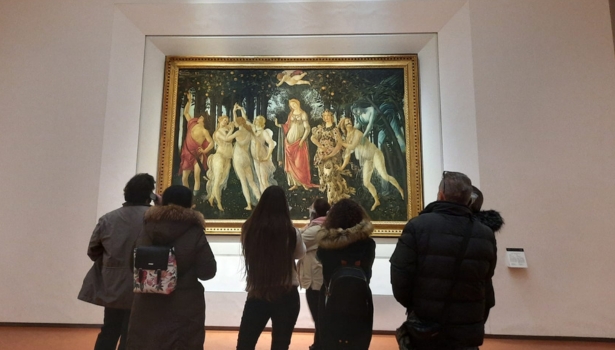
SMALL GROUP UFFIZI GALLERY GUIDED TOUR
Discover the wonders of the Uffizi Gallery with our exclusive guided tour! Book now and enjoy the expertise of an official guide who will bring the masterpieces to life. With our skip-the-line tickets, you’ll bypass the queues and dive straight into the world of Renaissance art.
Explore iconic works by Botticelli, Michelangelo, and Leonardo da Vinci, among others, while gaining fascinating insights from our knowledgeable guide. Don’t miss this opportunity to experience one of the world’s most renowned museums in the most convenient and enriching way. Reserve your spot today for an unforgettable journey through art history!
Language: English
Frequency: everyday
Starting time: 3.00 pm
Duration: about 3 hours
Price: 65.00 euros per person in low season. High season price: 79.00 euros.
Price includes: 3 hour guided tour, Masterclass with an art expert (English-speaking licensed guide), Uffizi Gallery skip-the-line tickets and earphones for groups over 5 people.
This tour will take place rain or shine.
Children: free under 3 years of age.
Children 4-11 years old pay 55,00 euro in low season and 67,00 euro in high season.
Meeting point with your guide: the meeting point is in Florence city centre and will be communicated on your confirmation voucher.
Meeting time: 2:45 pm. Please arrive 15 minutes before the tour starting time.
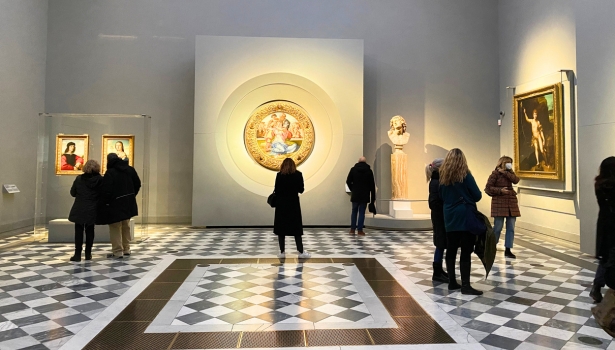
Uffizi Gallery Guided Tour in English: itinerary details
Our Uffizi Gallery Guided Tour in English starts with the east corridor on the second floor. The ancient sculptures arranged along the corridor depict the busts of the most famous Roman emperors, placed opposite the statues of their consorts. On the walls are exposed two series of paintings, those of smaller size form the so-called Giovo Series, and representing the illustrious characters of the past; the biggest ones make up the Aulica Series, in which the members of the Medici family are portrayed.
So we enter the first room of our Uffizi Gallery Guided Tour in English: the Sala delle Maestà. Here, there are three magnificent altarpieces. On the left stands the Rucellai Madonna painted in 1285 by Duccio di Buoninsegna, on the right Cimabue with the Santa Trinità Maestà built in 1280, in the centre the room the Madonna Enthroned (also known as Ognissanti Madonna) one of the most famous masterpieces of Giotto 1300s.
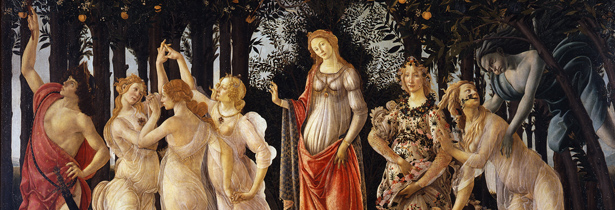
The visit continues in Room 3 where we can admire the Annunciation by Simone Martini, one of the most important examples of Sienese Gothic painting, in which it is possible to perceive a hint of perspective in the pavement drawing.
Room number 7 opens us to the International Gothic; the most important work of this period is the Adoration of the Magi, by Gentile da Fabriano.
We continue our Uffizi Gallery Guided Tour in English and we enter the room dedicated to Filippo Lippi. This artist was certainly one of the most important of the XVth century. The work that most stands out for its beauty is undoubtedly The Madonna with Child and Angels; this painting, which hides a romantic story, was the most important also for the artistic life of another painter who was a pupil of Filippo Lippi: Botticelli.
We continue our visit by dwelling in the rooms where Botticelli's works are exhibited: Primavera, the Birth of Venus, Pallas and the Centaur, the Calumny of Apelles, the Cestello Annunciation.
We now move to Room number 15, dedicated to the priceless masterpieces of Leonardo da Vinci. From the Adoration of the Magi to the Baptism of Christ is tangible the immense creativity, skill and passion of a man who has left us incredible masterpieces and mysteries that perhaps we will never be able to solve. In his paintings, from the Adoration of the Magi to the Baptism of Christ, we experience the immense creativity, skill and passion of a man who has left us incredible masterpieces and mysteries that perhaps we will never be able to solve.
It is now time to look back into Room 35. Here is the only painting by Michelangelo present in Florence: the Doni Tondo. Probably painted for the Doni-Strozzi spouses, the scene represented by Buonarroti is full of novelties and will ensure this extraordinary artist a place among the inspirers of Mannerism.
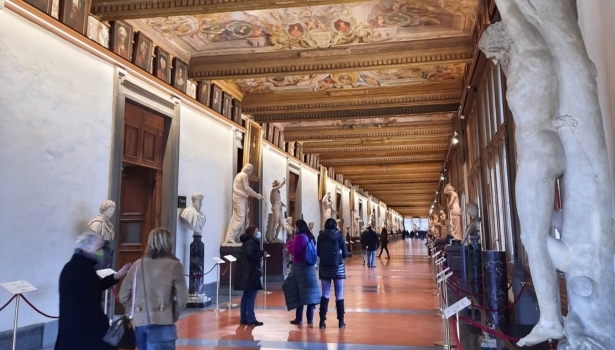
Michelangelo painter at the Uffizi Gallery the Tondo Doni
Michelangelo at the Uffizi Gallery: the Doni Tondo
Due to the acclaim that met the Pietà in Rome, Michelangelo upon returning to Florence was bombarded with commissions, among them, as has been seen, the crucially important one for the David . The other works from this most intense Florentine period are: another bronze David (now lost) for the French Marshal Pierre de Rohan; the twelve Apostles commissioned by the Wool Guild for the Florentine Cathedral, of which only a Saint Matthew was to be roughed out; the Madonna and the Child bought by the Mouscron family from Bruges for their chapel in the Notre-Dame Church in the Flemish city; the Pitti Tondo and the Taddei Tondo, so called from the names of their clients, as well as the very famous work that introduced Michelangelo as a painter, the Doni Tondo (now at the Uffizi Gallery in Florence); and lastly, the unfinished Battle of Cascina.
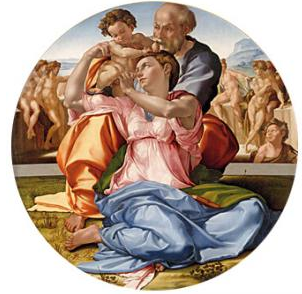 The Doni Tondo is considered to be the only panel painting by Michelangelo although some experts are also inclined to attribute to the artist a few paintings accomplished before the masterpiece now in the Uffizi, such as the so-called Manchester Madonna, now at the National Gallery in London and, with more caution, the Deposition in the Tomb from the same museum.
The Doni Tondo is considered to be the only panel painting by Michelangelo although some experts are also inclined to attribute to the artist a few paintings accomplished before the masterpiece now in the Uffizi, such as the so-called Manchester Madonna, now at the National Gallery in London and, with more caution, the Deposition in the Tomb from the same museum.
The Holy Family of the Doni Tondo was painted for Agnolo Doni and his wife Maddalena Strozzi, perhaps on the occasion of their marriage, celebrated between 1503 and 1504 or, it has been suggested, some years later, between 1506 and 1507; in any case, some time around that 1506, when another great artist of the period, Raphael, painted splendid portraits of the married couple. The composition on a round support follow the most typical 15th century Florentine tradition, having been used, for example, in the Madonna of the Pomegranate by Sandro Botticelli and the Madonna of Humility by Luca Signorelli, from which Michelangelo obviously drew some inspiration.
In the Doni Tondo, however, Michelangelo’s bold experimentation is already accentuated. In the first place, the iconography of the group with the Madonna twisting to receive, over her shoulder, the Child handed her by Saint Joseph, is unsual. The virgin appearence too is atipycal. Maria has strong, robust features and is portrayed without a veil, dressed in classical style with bare arms, a physiognomy that seems to anticipate the Sibyls painted on the ceiling of the Sistine Chapel. Then there are the colours: light and cold, harshly juxtaposed and iridiscent, a color scheme that is a prelude to the palette revealed by restoration of the Sistine, in sharp contrast with the taste of the period for pleasing, harmoniuos tones. Moreover, the young nudes in the background recall the “Ignudi” painted on the famous celeing of the Sistine.
Already in the Doni Tondo, as later in the masterpiece frescoed in the Vatican, Michelangelo’s work appears to painted sculpture, with the holy group in the Uffizi panel showing a strong three-dimensional effect, its plasticity underlined still further by the sharp contrast between light and shadow. As regards its meaning, the Florentine painting seems to allude to the division of humanity before and after the birth of Christ. If so, the nudes in the background are not classical figures of shepherds, as in the painting by Luca Signorelli, but probably represent the pagan world before Revelation.
Uffizi Tour: the Itinerary
The Uffizi Gallery is one of the most famous museums in the world, and it is housed in the former “uffizi” or “offices” of the Medici Family. Your knowledgeable guide will explain the works of the greatest artists from the Middle Ages to the Renaissance: Cimabue, Giotto, Botticelli, Leonardo da Vinci, Michelangelo, Raphael, Titian, and many more. You will recognize and see close-up original world-famous paintings that you have seen all your life in books, magazines, and on TV. You can learn the secrets of the artists’ craft, techniques and tools. Looking at the most famous artworks of the period, you can understand why Florence is the birthplace of the Renaissance. Personalize your museum experience. At the end of the tour, you do not have to rush away. You can remain in the museum until closing time, so you have plenty of opportunity to make your list of personal favourites.









